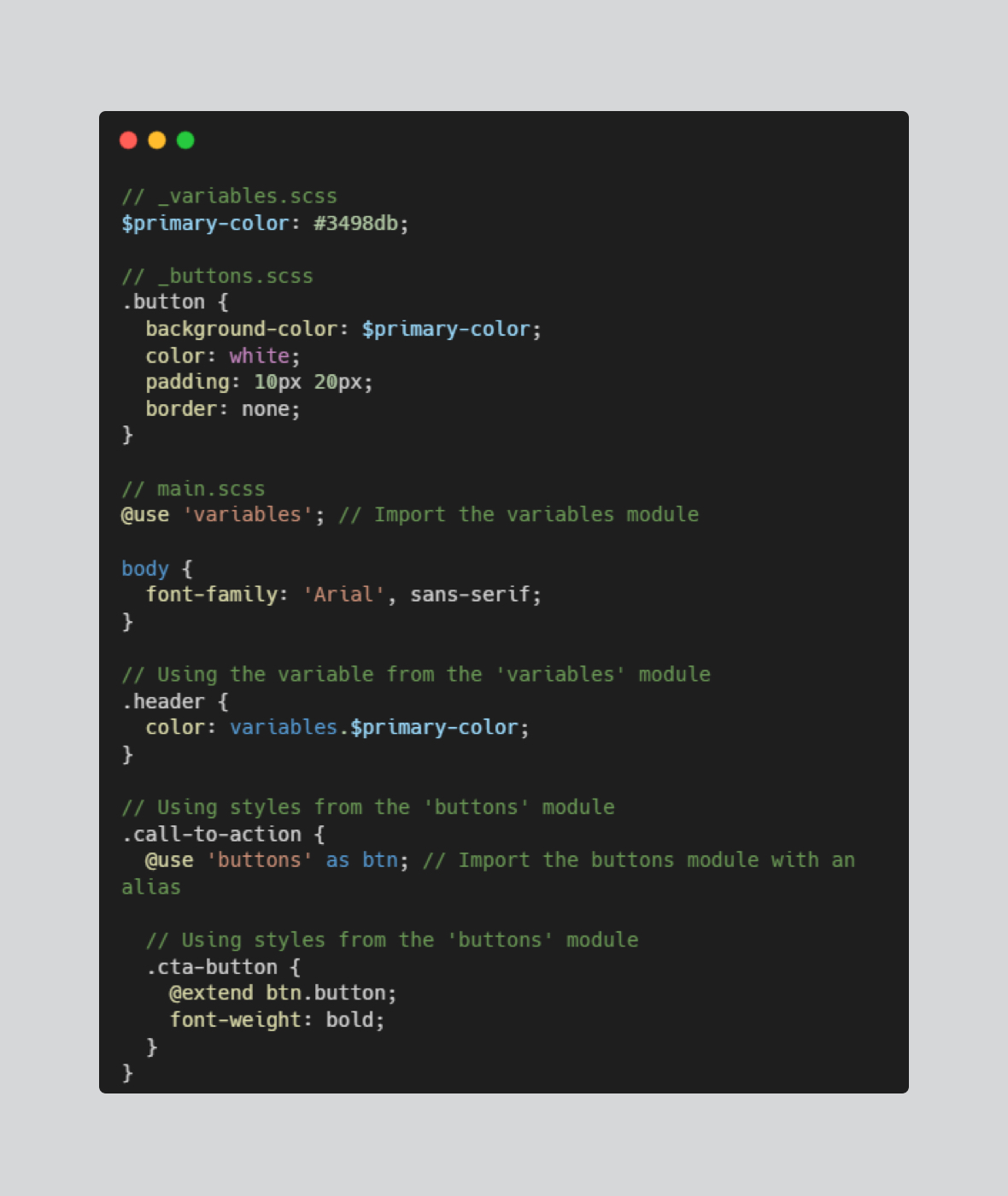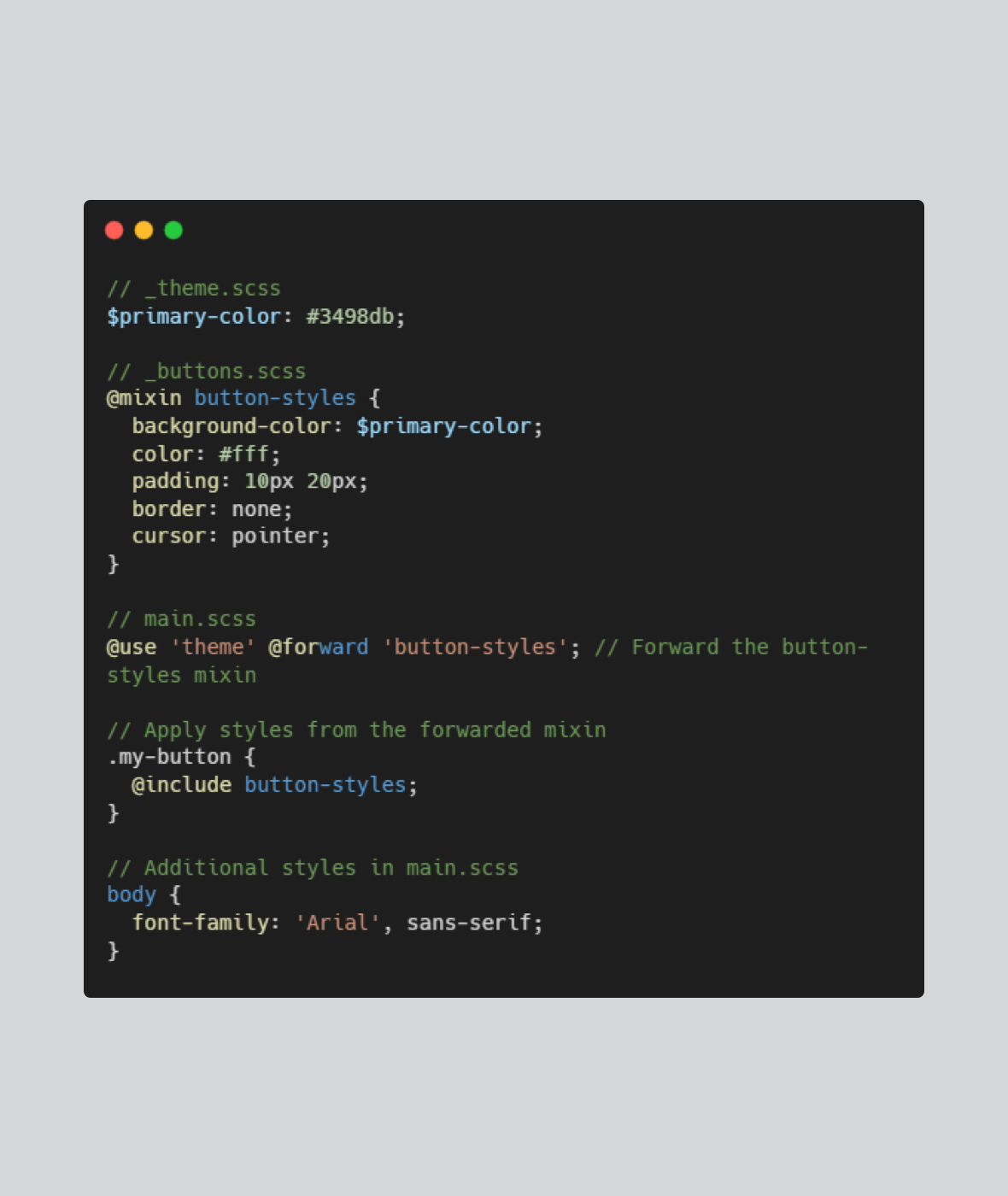In October 2019, the team at SASS announced that the @import rule is to be gradually phased out once an adoption rate of 80% for Dart Sass was reached. This adoption rate was reached in March 2023, meaning that @import’s days are numbered.
The next iteration of SASS’ module import system introduces the @use and @forward rules. Departing from @import, these rules bring modularity and improved collaboration. @use encapsulates styles within namespaces, reducing global scope issues, while @forward streamlines sharing mixins and functions between modules. This marks a significant leap forward, offering developers cleaner, more maintainable, and scalable stylesheets.
@use in practice
The SASS @use rule offers a more modular and encapsulated approach in comparison to its predecessor. When using the @use rule to import a module, it establishes a unique namespace for that module, allowing for naming conflicts and global scope issues to be avoided.
Styles, variables, mixins, and functions from each module are encapsulated, preventing unintended interference from other modules. Additionally, the @use rule allows for precise control over which components are exposed and accessible to other modules.
One excellent use case for this namespacing is working with external CSS libraries. By encapsulating styles within their designated modules, developers can seamlessly integrate third-party libraries without the fear of inadvertent clashes with internal styles.
Another advantage of @use is its positive impact on compilation times. The modularisation and unique namespaces created by @use enable the compiler to process only the styles related to the specific module being compiled.

@forward in practice
The SASS @forward rule serves as a system for sharing mixins and functions across modules. Unlike @use, which primarily deals with styles, @forward is focused on efficiently sharing reusable code snippets, enhancing code reusability and maintaining a modular codebase.
When a module uses @forward to expose specific mixins or functions, it essentially acts as a bridge, allowing other modules to easily utilise those shared code elements. This ensures a more organised coding environment, where commonly used utilities or functions are efficiently shared between different parts of a project.
One notable advantage of the @forward rule is its role in reducing redundancy. Instead of duplicating mixins or functions in multiple modules, @forward allows them to be defined in a single location and forwarded to other modules as needed (hence the name). This promotes a more efficient development process and ensures consistency in the application of shared code, contributing to a cleaner and more maintainable codebase.

Navigating the pitfalls
Like all emerging rules, @use and @forward come with their own set of potential pitfalls and mistakes that developers should be aware of. Understanding these and knowing how to navigate around them is crucial for harnessing the full potential of these features.
Firstly, the overuse or unnecessary application of the @use rule. While it provides encapsulation and avoids global scope issues, applying it indiscriminately to every module may result in an overly complex namespace structure.
Over-reliance on removing namespacing using the ‘ * ‘ character when importing via the @use rule is also a common mistake developers make. While it allows for simplified access to all features of a module without explicit namespacing, relying on it excessively can diminish the benefits of the more controlled scoping offered by @use. Developers should carefully consider whether the convenience of the ‘ * ‘ character aligns with the intended structure and modularity goals of their project.

Another pitfall is the overuse of the ‘*’ character to remove the namespace of a module when importing it via the @use rule. While there certainly are some use cases for the ‘*’ character, removing namespaces from your modules opens them up to style conflicts and goes against the very philosophy behind this new module system.
Additionally, understanding the proper application of @forward is crucial to avoiding pitfalls. One mistake is forwarding entire modules rather than specific mixins or functions. This can inadvertently expose more than intended and lead to potential conflicts.
SASS’ @use and @forward rules mark the beginning of a new era in stylesheet organisation. The @use rule facilitates modular and intentional development by encapsulating styles within namespaces and optimising compilation times. Meanwhile, the @forward rule streamlines the sharing of mixins and functions, reducing redundancy and enhancing code maintainability.
Embracing the @use and @forward rules empowers developers to create scalable, organised, and collaborative stylesheets. By navigating potential pitfalls and adopting best practices, these rules pave the way for an efficient, intentional, and collaborative styling workflow.




